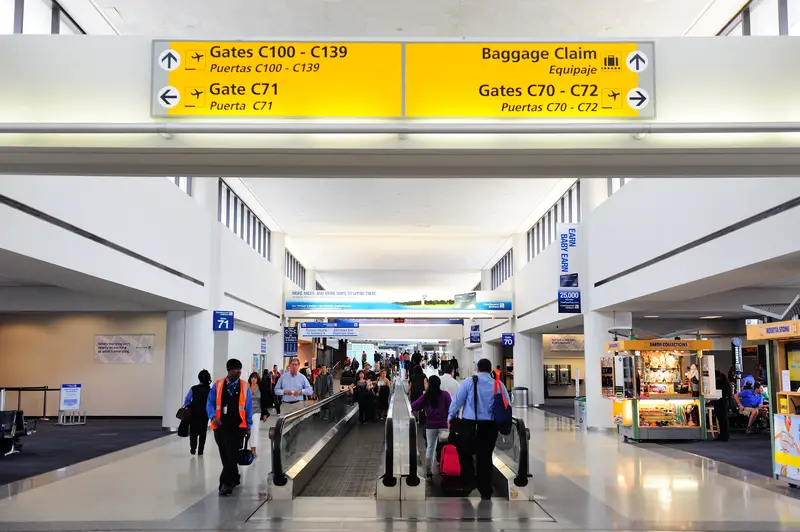Planning a trip with layovers can be stressful enough, but choosing the wrong connecting airport might turn your travel plans into a complete disaster. Recent studies and passenger feedback have identified several US airports where layovers consistently create headaches for travelers. From marathon walks between terminals to frequent weather delays, these airports pose significant risks to your travel schedule.
Newark Liberty International tops the list of worst layover spots
Newark Liberty International Airport (EWR) consistently ranks as the most problematic airport for layovers in the United States. The airport’s notorious reputation stems from its chronically long security lines and frequent delays that can wreak havoc on connecting flight schedules. Despite its proximity to New York City, the airport’s infrastructure struggles to handle passenger volume efficiently.
The terminal layout at Newark presents significant challenges for travelers with tight connections. Passengers regularly face lengthy walks between gates, and the inter-terminal transportation system often experiences delays. The airport’s limited seating areas and expensive Wi-Fi service add extra frustration for those stuck during extended waits.
Weather-related delays compound the problems at Newark, particularly during winter months. The airport’s position in the busy Northeast corridor makes it susceptible to cascading delays that can affect flight schedules throughout the day. Staff interactions often receive negative reviews, with many travelers reporting unhelpful responses to delay-related concerns.
The amenities at Newark fall short of expectations for a major international hub. Many restaurants close early, leaving late-night travelers with limited dining options. The cramped waiting areas and insufficient charging stations create additional stress for passengers dealing with delayed connections.
Chicago O’Hare makes connections unnecessarily complicated
Chicago O’Hare International Airport (ORD) presents a maze-like challenge for connecting passengers. The sheer size of the airport, combined with its complex terminal layout, makes navigating between gates a time-consuming ordeal. International travelers face particular difficulties when transferring to domestic flights, often requiring security rescreening and long walks between terminals.
The airport’s reputation for weather-related disruptions causes frequent scheduling chaos. Winter storms regularly impact operations, leading to cascading delays and cancellations. The high volume of connecting traffic means that when delays occur, finding alternative flights becomes extremely challenging.
Terminal conditions at O’Hare often fall below passenger expectations. Overcrowded gate areas provide insufficient seating, forcing many travelers to sit on floors during delays. The distance between concourses can require up to 30 minutes of walking time, creating stress for those with tight connections.
Customer service at O’Hare receives mixed reviews, with many passengers reporting difficulty finding assistance during irregular operations. The airport’s size works against it during disruptions, as staff struggle to manage the volume of affected travelers seeking help with rebooking or information about delays.
Los Angeles International frustrates with terminal transfers
Los Angeles International Airport (LAX) tests traveler patience with its horseshoe-shaped layout and inefficient terminal connections. The airport’s design requires passengers to exit security and often walk outside or take shuttles between terminals, adding considerable time and stress to connections. During peak hours, the terminal loop road experiences severe congestion.
The inter-terminal shuttle system at LAX often proves unreliable and time-consuming. Buses frequently run behind schedule due to traffic, and waiting times can extend to 20 minutes or more. This uncertainty makes it difficult for passengers to plan their terminal transfers effectively.
Security lines at LAX present another major hurdle for connecting passengers. Having to re-clear security when changing terminals adds significant time to connections. The inconsistent enforcement of priority lanes and PreCheck benefits across different terminals creates additional confusion.
Amenities between terminals vary dramatically at LAX, with some offering modern conveniences while others remain dated and limited in options. The airport’s ongoing construction projects, while promising future improvements, currently add to the confusion and delays faced by connecting passengers.
Denver International requires serious walking stamina
Denver International Airport (DEN) holds the record for requiring the longest walks between gates, with some connections demanding up to 34 minutes of brisk walking. The airport’s massive size and spread-out terminal design create significant challenges for passengers with tight connections or mobility issues.
The underground train system, while efficient when running normally, can experience delays during peak times. Additionally, the high altitude of Denver can make these long walks more challenging for passengers not accustomed to the elevation, particularly when rushing to make a connection.
Weather disruptions at Denver can severely impact connection reliability. The airport’s location makes it susceptible to sudden weather changes, including snow storms and strong winds. These conditions frequently lead to delayed arrivals and missed connections.
Gate information at Denver often changes with little notice, requiring passengers to stay alert and potentially adjust their walking routes. The terminal’s linear design means that when gate changes occur, they can add significant distance to an already long journey between connections.
Miami International struggles with basic service delivery
Miami International Airport (MIA) consistently disappoints connecting passengers with its sub-par amenities and service quality. The airport’s reputation for poor dining options becomes particularly problematic during layovers, as many restaurants close early or offer limited service during off-peak hours.
The terminal layout at Miami creates confusion for many travelers. Signage between terminals can be unclear, and the distance between some gates requires significant walking time. The airport’s aging infrastructure in certain areas contributes to passenger discomfort during extended waits.
Customer service at Miami often falls short of expectations. Staff assistance can be difficult to find, and language barriers sometimes complicate communication. During irregular operations, the airport struggles to manage the flow of affected passengers efficiently.
The airport’s location makes it vulnerable to weather delays, particularly during hurricane season. These weather-related disruptions can cascade through the system, affecting connections and creating extended delays for travelers.
Orlando International creates unexpected connection challenges
Orlando International Airport (MCO) ranks surprisingly poorly for layovers, with issues ranging from insufficient seating to limited charging options. The airport’s popularity with leisure travelers and families often results in overcrowded terminals and long lines at security checkpoints.
The terminal design at Orlando can create confusion for connecting passengers. Walking distances between gates can be substantial, and the people-mover system sometimes experiences delays. During peak tourist seasons, the congestion in terminals makes navigation particularly challenging.
Amenities at Orlando often disappoint travelers expecting more from a major tourist destination. The limited number of charging ports creates competition for power access during layovers. Seating areas frequently become overcrowded, forcing passengers to sit on floors.
Weather delays, particularly during Florida’s thunderstorm season, can significantly impact connection reliability. The airport’s operations can be disrupted by afternoon storms, leading to delayed arrivals and missed connections for many travelers.
Fort Lauderdale Hollywood International faces multiple issues
Fort Lauderdale Hollywood International Airport (FLL) presents numerous challenges for connecting passengers. The airport’s limited dining options and cleanliness issues create an uncomfortable environment for those facing extended layovers. The cramped departure gates often leave passengers competing for limited seating.
Terminal transfers at Fort Lauderdale can be time-consuming and confusing. The airport’s layout requires passengers to exit and re-enter security when moving between some terminals, adding unnecessary time and stress to connections. The shuttle system between terminals operates on an inconsistent schedule.
Technical infrastructure at Fort Lauderdale needs improvement. The limited number of charging stations poses problems for travelers needing to keep devices powered during delays. Wi-Fi connectivity can be unreliable, particularly during peak usage periods.
Weather-related delays frequently impact operations at Fort Lauderdale, especially during summer thunderstorm season. The airport’s proximity to the coast makes it susceptible to weather disruptions that can affect flight schedules throughout the day.
Baltimore Washington International offers limited amenities
Baltimore Washington International Airport (BWI) struggles with providing adequate amenities for connecting passengers. Over 15% of flights experience delays, and the limited facilities make extended waits particularly uncomfortable. The airport’s amenities vary significantly between concourses, with some areas offering notably fewer options than others.
Terminal conditions at BWI often fall below expectations. Concourse C, in particular, receives frequent complaints about limited dining options and dated facilities. The seating areas in many parts of the airport prove insufficient during busy periods.
Connection times at BWI can be deceptive. While the airport’s size might suggest easy transfers, security lines and distance between certain gates can make tight connections stressful. The airport’s simplified layout doesn’t compensate for its operational challenges.
Customer service at BWI receives mixed reviews, with many passengers reporting difficulty finding assistance during irregular operations. The airport’s resources often seem stretched thin, particularly when handling delayed or cancelled flights.
Salt Lake City International requires significant walking
Salt Lake City International Airport (SLC) challenges connecting passengers with its extensive walking requirements. Despite recent renovations, the airport’s design creates long distances between gates, making tight connections particularly stressful. The linear terminal layout means that reaching distant gates requires considerable time and effort.
The airport’s location at high altitude can make these long walks more challenging for some passengers. Those not accustomed to the elevation might find themselves out of breath when rushing to make connections, especially when carrying luggage.
While the new terminal offers modern amenities, the distance between facilities can make accessing them impractical during shorter layovers. The time required to reach restaurants or shops might consume most of a brief connection window.
Weather conditions at Salt Lake City can impact flight reliability, particularly during winter months. Snow and ice can lead to delays and cancellations, affecting connecting flights throughout the network. The airport’s mountain location makes it susceptible to weather-related disruptions.
Washington Dulles confuses with its layout
Washington Dulles International Airport (IAD) frustrates connecting passengers with its confusing layout and long distances between terminals. The airport’s design often requires travelers to navigate a complex system of mobile lounges or AeroTrain connections, adding uncertainty to transfer times.
The mobile lounge system, while unique, can be time-consuming and unreliable. These transport vehicles sometimes experience delays or mechanical issues, making connection times unpredictable. The alternative AeroTrain system doesn’t serve all areas of the airport.
Terminal amenities at Dulles vary significantly between concourses. Some areas offer modern facilities while others feel dated and provide limited services. Finding dining options or comfortable seating can be challenging in certain parts of the airport.
Weather delays at Dulles, particularly during winter months, can significantly impact connection reliability. The airport’s position in the Northeast corridor makes it susceptible to winter storms and other weather-related disruptions that affect flight schedules.
When planning your next trip, consider these airport rankings carefully before booking connecting flights. While direct flights might cost more initially, they could save you from the stress, uncertainty, and potential disruption of layovers at these challenging airports. Remember that your connection choice can significantly impact your overall travel experience.

